Analysis of Defined Benefit Plans and Investment Choice Plans
VerifiedAdded on 2021/05/31
|10
|2635
|20
Report
AI Summary
This report provides a comprehensive overview of defined benefit plans and investment choice plans, focusing on their characteristics and the factors influencing investment decisions. It defines both plan types, highlighting the role of tertiary employees in financial planning. The report delves into key issues such as the time value of money, inflation rates, and taxes, examining their impact on investment returns. Through a comparative analysis, the report explores the advantages and disadvantages of each plan type, offering recommendations for making informed investment choices. The conclusion emphasizes the importance of considering various factors when selecting an investment plan and the need for a thorough analysis of benefits and drawbacks before making any investment decisions. This report serves as a valuable resource for understanding the complexities of investment planning and making sound financial choices.

Defined Benefit Plan
Tertiary employees
Name of the Student
Tertiary employees
Name of the Student
Paraphrase This Document
Need a fresh take? Get an instant paraphrase of this document with our AI Paraphraser
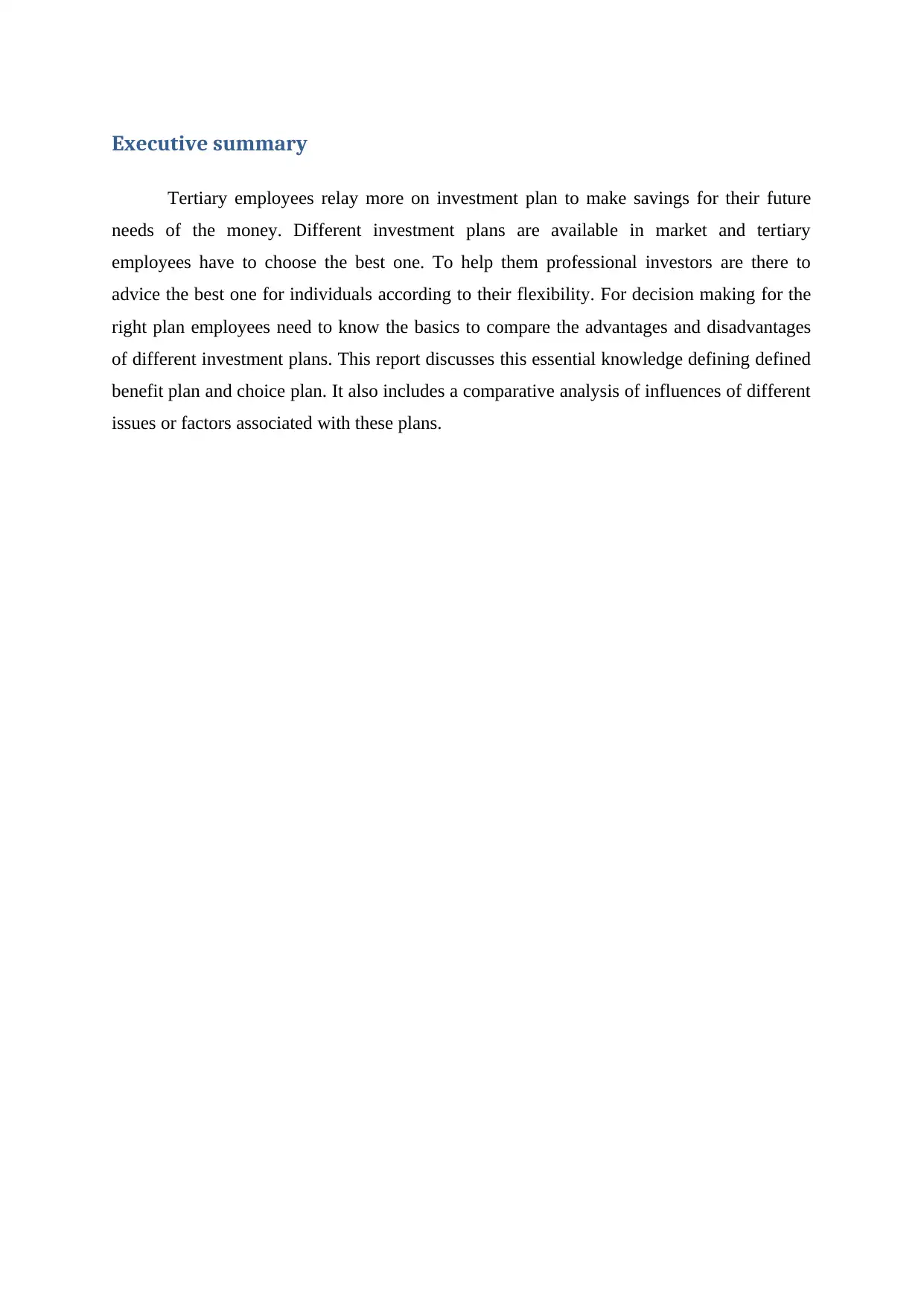
Executive summary
Tertiary employees relay more on investment plan to make savings for their future
needs of the money. Different investment plans are available in market and tertiary
employees have to choose the best one. To help them professional investors are there to
advice the best one for individuals according to their flexibility. For decision making for the
right plan employees need to know the basics to compare the advantages and disadvantages
of different investment plans. This report discusses this essential knowledge defining defined
benefit plan and choice plan. It also includes a comparative analysis of influences of different
issues or factors associated with these plans.
Tertiary employees relay more on investment plan to make savings for their future
needs of the money. Different investment plans are available in market and tertiary
employees have to choose the best one. To help them professional investors are there to
advice the best one for individuals according to their flexibility. For decision making for the
right plan employees need to know the basics to compare the advantages and disadvantages
of different investment plans. This report discusses this essential knowledge defining defined
benefit plan and choice plan. It also includes a comparative analysis of influences of different
issues or factors associated with these plans.
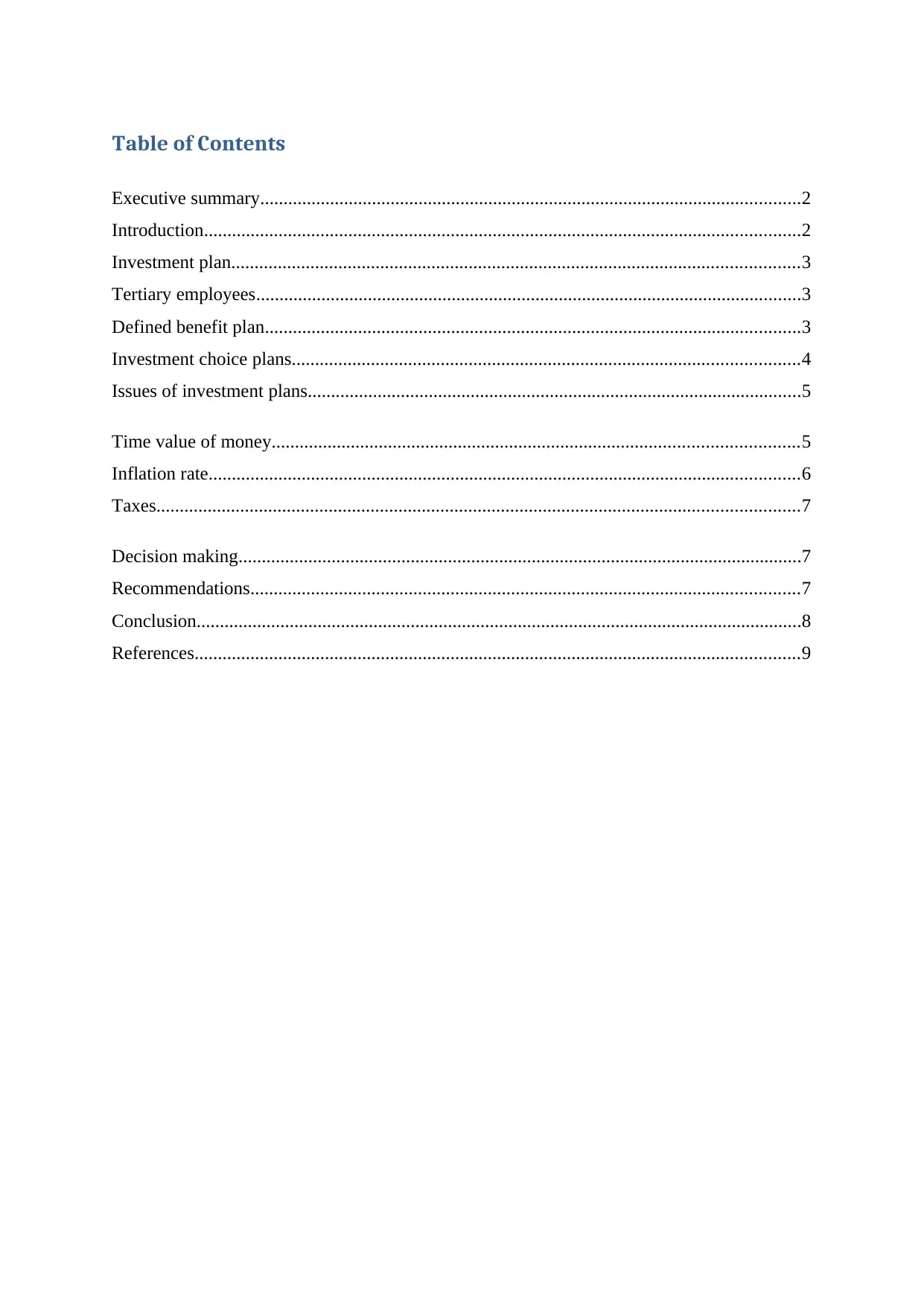
Table of Contents
Executive summary....................................................................................................................2
Introduction................................................................................................................................2
Investment plan..........................................................................................................................3
Tertiary employees.....................................................................................................................3
Defined benefit plan...................................................................................................................3
Investment choice plans.............................................................................................................4
Issues of investment plans..........................................................................................................5
Time value of money.................................................................................................................5
Inflation rate...............................................................................................................................6
Taxes..........................................................................................................................................7
Decision making.........................................................................................................................7
Recommendations......................................................................................................................7
Conclusion..................................................................................................................................8
References..................................................................................................................................9
Executive summary....................................................................................................................2
Introduction................................................................................................................................2
Investment plan..........................................................................................................................3
Tertiary employees.....................................................................................................................3
Defined benefit plan...................................................................................................................3
Investment choice plans.............................................................................................................4
Issues of investment plans..........................................................................................................5
Time value of money.................................................................................................................5
Inflation rate...............................................................................................................................6
Taxes..........................................................................................................................................7
Decision making.........................................................................................................................7
Recommendations......................................................................................................................7
Conclusion..................................................................................................................................8
References..................................................................................................................................9
⊘ This is a preview!⊘
Do you want full access?
Subscribe today to unlock all pages.

Trusted by 1+ million students worldwide
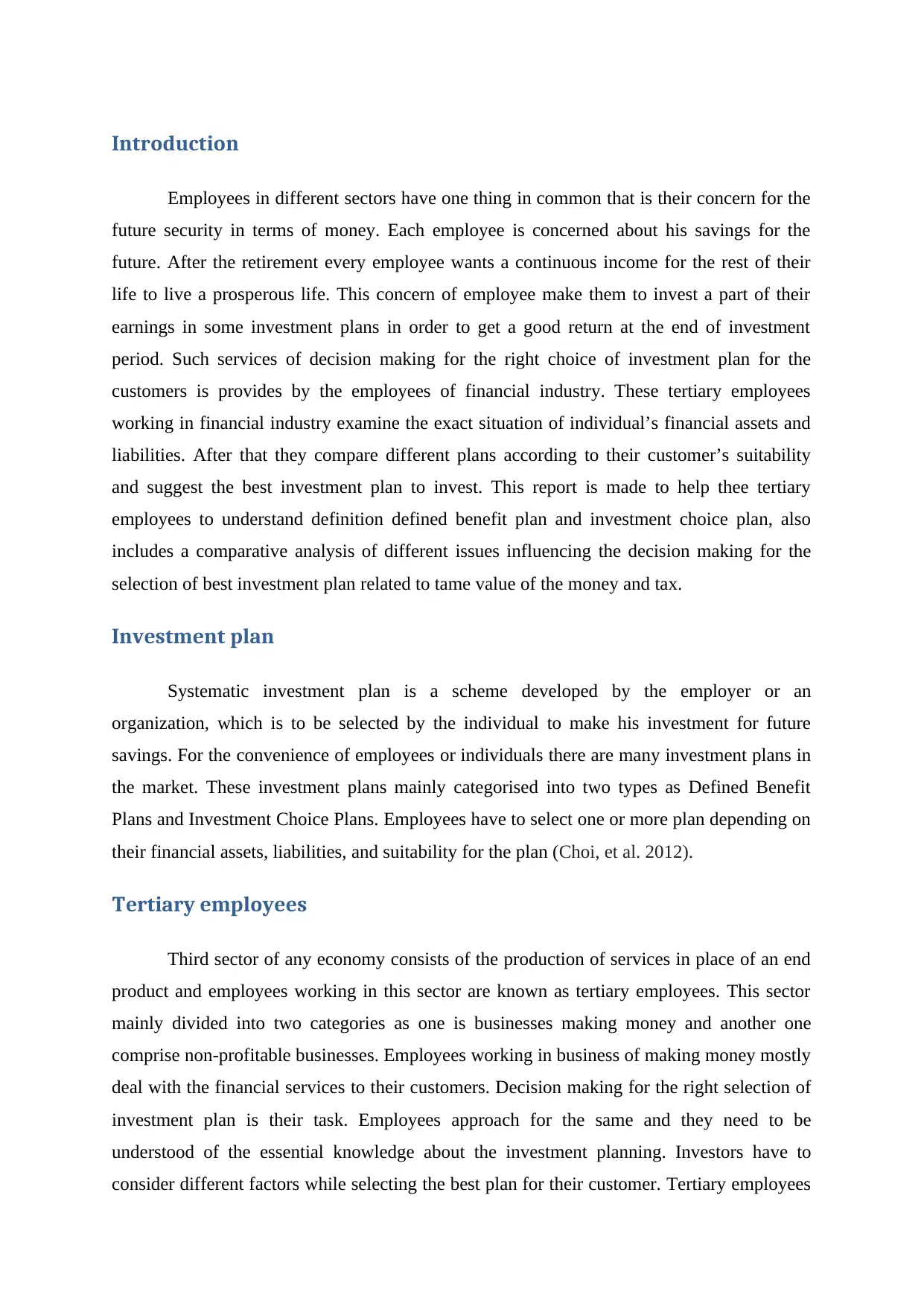
Introduction
Employees in different sectors have one thing in common that is their concern for the
future security in terms of money. Each employee is concerned about his savings for the
future. After the retirement every employee wants a continuous income for the rest of their
life to live a prosperous life. This concern of employee make them to invest a part of their
earnings in some investment plans in order to get a good return at the end of investment
period. Such services of decision making for the right choice of investment plan for the
customers is provides by the employees of financial industry. These tertiary employees
working in financial industry examine the exact situation of individual’s financial assets and
liabilities. After that they compare different plans according to their customer’s suitability
and suggest the best investment plan to invest. This report is made to help thee tertiary
employees to understand definition defined benefit plan and investment choice plan, also
includes a comparative analysis of different issues influencing the decision making for the
selection of best investment plan related to tame value of the money and tax.
Investment plan
Systematic investment plan is a scheme developed by the employer or an
organization, which is to be selected by the individual to make his investment for future
savings. For the convenience of employees or individuals there are many investment plans in
the market. These investment plans mainly categorised into two types as Defined Benefit
Plans and Investment Choice Plans. Employees have to select one or more plan depending on
their financial assets, liabilities, and suitability for the plan (Choi, et al. 2012).
Tertiary employees
Third sector of any economy consists of the production of services in place of an end
product and employees working in this sector are known as tertiary employees. This sector
mainly divided into two categories as one is businesses making money and another one
comprise non-profitable businesses. Employees working in business of making money mostly
deal with the financial services to their customers. Decision making for the right selection of
investment plan is their task. Employees approach for the same and they need to be
understood of the essential knowledge about the investment planning. Investors have to
consider different factors while selecting the best plan for their customer. Tertiary employees
Employees in different sectors have one thing in common that is their concern for the
future security in terms of money. Each employee is concerned about his savings for the
future. After the retirement every employee wants a continuous income for the rest of their
life to live a prosperous life. This concern of employee make them to invest a part of their
earnings in some investment plans in order to get a good return at the end of investment
period. Such services of decision making for the right choice of investment plan for the
customers is provides by the employees of financial industry. These tertiary employees
working in financial industry examine the exact situation of individual’s financial assets and
liabilities. After that they compare different plans according to their customer’s suitability
and suggest the best investment plan to invest. This report is made to help thee tertiary
employees to understand definition defined benefit plan and investment choice plan, also
includes a comparative analysis of different issues influencing the decision making for the
selection of best investment plan related to tame value of the money and tax.
Investment plan
Systematic investment plan is a scheme developed by the employer or an
organization, which is to be selected by the individual to make his investment for future
savings. For the convenience of employees or individuals there are many investment plans in
the market. These investment plans mainly categorised into two types as Defined Benefit
Plans and Investment Choice Plans. Employees have to select one or more plan depending on
their financial assets, liabilities, and suitability for the plan (Choi, et al. 2012).
Tertiary employees
Third sector of any economy consists of the production of services in place of an end
product and employees working in this sector are known as tertiary employees. This sector
mainly divided into two categories as one is businesses making money and another one
comprise non-profitable businesses. Employees working in business of making money mostly
deal with the financial services to their customers. Decision making for the right selection of
investment plan is their task. Employees approach for the same and they need to be
understood of the essential knowledge about the investment planning. Investors have to
consider different factors while selecting the best plan for their customer. Tertiary employees
Paraphrase This Document
Need a fresh take? Get an instant paraphrase of this document with our AI Paraphraser
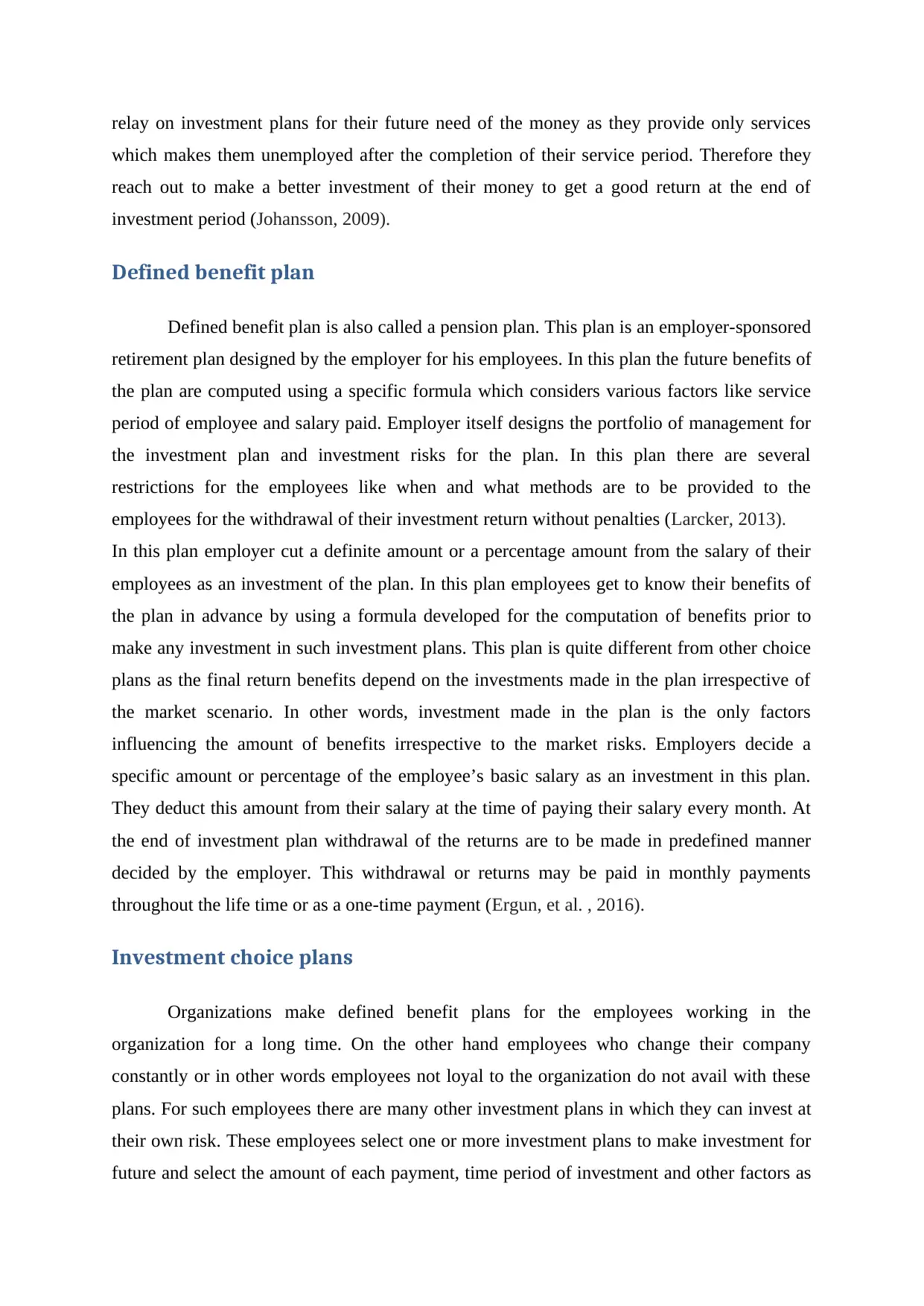
relay on investment plans for their future need of the money as they provide only services
which makes them unemployed after the completion of their service period. Therefore they
reach out to make a better investment of their money to get a good return at the end of
investment period (Johansson, 2009).
Defined benefit plan
Defined benefit plan is also called a pension plan. This plan is an employer-sponsored
retirement plan designed by the employer for his employees. In this plan the future benefits of
the plan are computed using a specific formula which considers various factors like service
period of employee and salary paid. Employer itself designs the portfolio of management for
the investment plan and investment risks for the plan. In this plan there are several
restrictions for the employees like when and what methods are to be provided to the
employees for the withdrawal of their investment return without penalties (Larcker, 2013).
In this plan employer cut a definite amount or a percentage amount from the salary of their
employees as an investment of the plan. In this plan employees get to know their benefits of
the plan in advance by using a formula developed for the computation of benefits prior to
make any investment in such investment plans. This plan is quite different from other choice
plans as the final return benefits depend on the investments made in the plan irrespective of
the market scenario. In other words, investment made in the plan is the only factors
influencing the amount of benefits irrespective to the market risks. Employers decide a
specific amount or percentage of the employee’s basic salary as an investment in this plan.
They deduct this amount from their salary at the time of paying their salary every month. At
the end of investment plan withdrawal of the returns are to be made in predefined manner
decided by the employer. This withdrawal or returns may be paid in monthly payments
throughout the life time or as a one-time payment (Ergun, et al. , 2016).
Investment choice plans
Organizations make defined benefit plans for the employees working in the
organization for a long time. On the other hand employees who change their company
constantly or in other words employees not loyal to the organization do not avail with these
plans. For such employees there are many other investment plans in which they can invest at
their own risk. These employees select one or more investment plans to make investment for
future and select the amount of each payment, time period of investment and other factors as
which makes them unemployed after the completion of their service period. Therefore they
reach out to make a better investment of their money to get a good return at the end of
investment period (Johansson, 2009).
Defined benefit plan
Defined benefit plan is also called a pension plan. This plan is an employer-sponsored
retirement plan designed by the employer for his employees. In this plan the future benefits of
the plan are computed using a specific formula which considers various factors like service
period of employee and salary paid. Employer itself designs the portfolio of management for
the investment plan and investment risks for the plan. In this plan there are several
restrictions for the employees like when and what methods are to be provided to the
employees for the withdrawal of their investment return without penalties (Larcker, 2013).
In this plan employer cut a definite amount or a percentage amount from the salary of their
employees as an investment of the plan. In this plan employees get to know their benefits of
the plan in advance by using a formula developed for the computation of benefits prior to
make any investment in such investment plans. This plan is quite different from other choice
plans as the final return benefits depend on the investments made in the plan irrespective of
the market scenario. In other words, investment made in the plan is the only factors
influencing the amount of benefits irrespective to the market risks. Employers decide a
specific amount or percentage of the employee’s basic salary as an investment in this plan.
They deduct this amount from their salary at the time of paying their salary every month. At
the end of investment plan withdrawal of the returns are to be made in predefined manner
decided by the employer. This withdrawal or returns may be paid in monthly payments
throughout the life time or as a one-time payment (Ergun, et al. , 2016).
Investment choice plans
Organizations make defined benefit plans for the employees working in the
organization for a long time. On the other hand employees who change their company
constantly or in other words employees not loyal to the organization do not avail with these
plans. For such employees there are many other investment plans in which they can invest at
their own risk. These employees select one or more investment plans to make investment for
future and select the amount of each payment, time period of investment and other factors as

per their own suitability. In other words we can say that investment choice plans are modified
by the employees not the employers. Return amount in these plans is associated with the
market risks. Most of the choice investment plans are related to the share price of
organizations providing such plans (Mouter, Van Cranenburgh, and van Wee, 2017).
Issues of investment plans
When it comes to the issues of investment plans every investment plan is associated
with some positive or negative impacts of several issuer related to the financial planning.
Returns made through these investment plans are the saving of earnings from the influence
many factors like time value of money and taxation. These issues influence the returns as per
the financial market scenario and provide some gain or losses to the investments made by the
employees. Some of the issues influencing the returns of different investment plans are
described as follow (Arensdorf, and Brungardt, 2017).
Time value of money
Time value of the money is defined as the difference in the worth value of money at
present time and in future. In other words we can say that an amount of money does not have
the same value in future as that of at present. Core principle of the finance also suggests the
providing money at resent can earn the significant amount of interest, therefore the worth of
amount is much more the earlier it is available. Using the same concept of making worth of
the money financial investors prefer to receive their money earlier instead of receiving the
same amount in future. For such assessment of the future value of money in order to make a
better investment a fundamental formula for the computation of future value off money is
used by the investors. This formula is as follows (Easterday, and Eaton, 2012).
FV = PV*[1+( i / n)](n*t)
Where
FV is future value of money
PV is present value of money
n is number of compounding period per year
t is number of years
This factor considers the interest rate of market to calculate the future value of
employee’s money. It provides a comparative difference in the two values of the same money
at present and in the future. For the tertiary employees it helps them to differentiate between
by the employees not the employers. Return amount in these plans is associated with the
market risks. Most of the choice investment plans are related to the share price of
organizations providing such plans (Mouter, Van Cranenburgh, and van Wee, 2017).
Issues of investment plans
When it comes to the issues of investment plans every investment plan is associated
with some positive or negative impacts of several issuer related to the financial planning.
Returns made through these investment plans are the saving of earnings from the influence
many factors like time value of money and taxation. These issues influence the returns as per
the financial market scenario and provide some gain or losses to the investments made by the
employees. Some of the issues influencing the returns of different investment plans are
described as follow (Arensdorf, and Brungardt, 2017).
Time value of money
Time value of the money is defined as the difference in the worth value of money at
present time and in future. In other words we can say that an amount of money does not have
the same value in future as that of at present. Core principle of the finance also suggests the
providing money at resent can earn the significant amount of interest, therefore the worth of
amount is much more the earlier it is available. Using the same concept of making worth of
the money financial investors prefer to receive their money earlier instead of receiving the
same amount in future. For such assessment of the future value of money in order to make a
better investment a fundamental formula for the computation of future value off money is
used by the investors. This formula is as follows (Easterday, and Eaton, 2012).
FV = PV*[1+( i / n)](n*t)
Where
FV is future value of money
PV is present value of money
n is number of compounding period per year
t is number of years
This factor considers the interest rate of market to calculate the future value of
employee’s money. It provides a comparative difference in the two values of the same money
at present and in the future. For the tertiary employees it helps them to differentiate between
⊘ This is a preview!⊘
Do you want full access?
Subscribe today to unlock all pages.

Trusted by 1+ million students worldwide

the best worst plans for their customers. While making a decision for the selection an
investment plan from defined benefit plan and choice plan investors would prefer to invest in
choice plans as they can choose the time period of investment in order to make more interest
modifying their investment in other profitable plans. On the other hand defined benefit plans
are locked for the given time period at the same rate of interest at present for the rest of time.
This results in a less return due to less interest rate used for the benefit calculations (Comprix,
and Muller 2011).
Inflation rate
Inflation rate is defined as the percentage change in value or price of services and
products after each year. High inflation rate requires a higher return from the investment
therefore investment are to me selected to get an enough return to meet the price change due
to inflation rate. In term of the influences of inflation rate choice plans are better than defined
benefit plans for higher inflation rates (Asthana, 2009).
Taxes
Employees invest in different investment plans to save their money from different
taxes as the investment plans imposes low tax in comparison to that of the direct income of
liabilities. Regarding tax exemption defined benefit plans comes under government policies
therefore in this plan there is a complete exemption of the tax. In this manner it is the
exceptional case among all other investment plans as other plans imposes some amount as tax
reduction but defined benefit plan does not impose any tax. Many investors practice tax
planning and invest in defined benefit plans because sometimes the tax is more than the
return. Therefore, in such situations investing in defined benefit plans saves more money than
the tax deduction in other plans (Clark, and Pitts, 2012).
Decision making
Decision making is the most challenging practice for the investors. At the time of
decision making investors have to consider all the advantages and disadvantages of the
respective investment plans prior to make an investment. For a right investment, investors
need to compare return benefits of different investment plans and then they consider the
suitability of customers for the respective plan. Issues associated with each investment plan
influence their credibility for its adoption by the customer (John, Koresko V John, 2015).
investment plan from defined benefit plan and choice plan investors would prefer to invest in
choice plans as they can choose the time period of investment in order to make more interest
modifying their investment in other profitable plans. On the other hand defined benefit plans
are locked for the given time period at the same rate of interest at present for the rest of time.
This results in a less return due to less interest rate used for the benefit calculations (Comprix,
and Muller 2011).
Inflation rate
Inflation rate is defined as the percentage change in value or price of services and
products after each year. High inflation rate requires a higher return from the investment
therefore investment are to me selected to get an enough return to meet the price change due
to inflation rate. In term of the influences of inflation rate choice plans are better than defined
benefit plans for higher inflation rates (Asthana, 2009).
Taxes
Employees invest in different investment plans to save their money from different
taxes as the investment plans imposes low tax in comparison to that of the direct income of
liabilities. Regarding tax exemption defined benefit plans comes under government policies
therefore in this plan there is a complete exemption of the tax. In this manner it is the
exceptional case among all other investment plans as other plans imposes some amount as tax
reduction but defined benefit plan does not impose any tax. Many investors practice tax
planning and invest in defined benefit plans because sometimes the tax is more than the
return. Therefore, in such situations investing in defined benefit plans saves more money than
the tax deduction in other plans (Clark, and Pitts, 2012).
Decision making
Decision making is the most challenging practice for the investors. At the time of
decision making investors have to consider all the advantages and disadvantages of the
respective investment plans prior to make an investment. For a right investment, investors
need to compare return benefits of different investment plans and then they consider the
suitability of customers for the respective plan. Issues associated with each investment plan
influence their credibility for its adoption by the customer (John, Koresko V John, 2015).
Paraphrase This Document
Need a fresh take? Get an instant paraphrase of this document with our AI Paraphraser
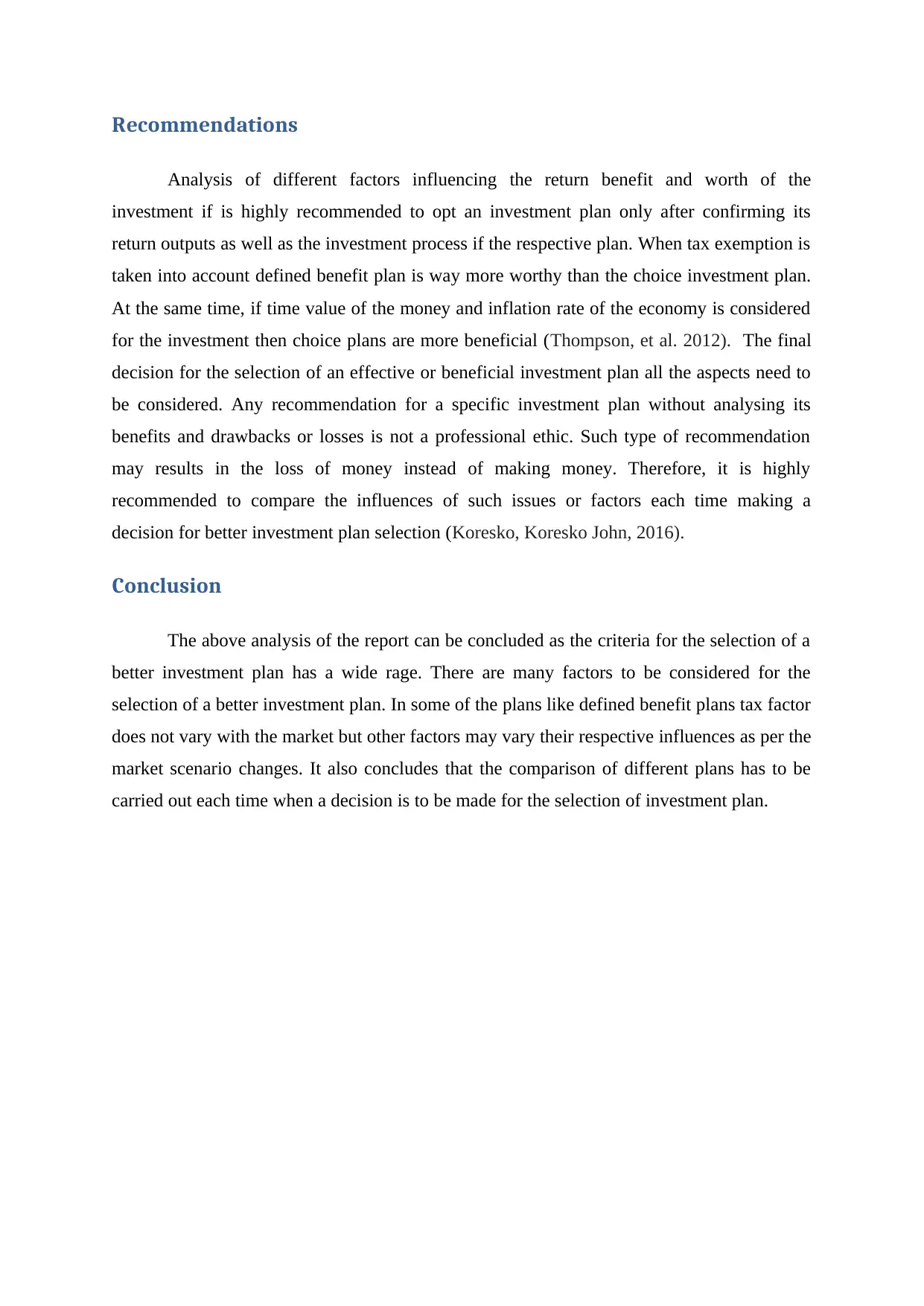
Recommendations
Analysis of different factors influencing the return benefit and worth of the
investment if is highly recommended to opt an investment plan only after confirming its
return outputs as well as the investment process if the respective plan. When tax exemption is
taken into account defined benefit plan is way more worthy than the choice investment plan.
At the same time, if time value of the money and inflation rate of the economy is considered
for the investment then choice plans are more beneficial (Thompson, et al. 2012). The final
decision for the selection of an effective or beneficial investment plan all the aspects need to
be considered. Any recommendation for a specific investment plan without analysing its
benefits and drawbacks or losses is not a professional ethic. Such type of recommendation
may results in the loss of money instead of making money. Therefore, it is highly
recommended to compare the influences of such issues or factors each time making a
decision for better investment plan selection (Koresko, Koresko John, 2016).
Conclusion
The above analysis of the report can be concluded as the criteria for the selection of a
better investment plan has a wide rage. There are many factors to be considered for the
selection of a better investment plan. In some of the plans like defined benefit plans tax factor
does not vary with the market but other factors may vary their respective influences as per the
market scenario changes. It also concludes that the comparison of different plans has to be
carried out each time when a decision is to be made for the selection of investment plan.
Analysis of different factors influencing the return benefit and worth of the
investment if is highly recommended to opt an investment plan only after confirming its
return outputs as well as the investment process if the respective plan. When tax exemption is
taken into account defined benefit plan is way more worthy than the choice investment plan.
At the same time, if time value of the money and inflation rate of the economy is considered
for the investment then choice plans are more beneficial (Thompson, et al. 2012). The final
decision for the selection of an effective or beneficial investment plan all the aspects need to
be considered. Any recommendation for a specific investment plan without analysing its
benefits and drawbacks or losses is not a professional ethic. Such type of recommendation
may results in the loss of money instead of making money. Therefore, it is highly
recommended to compare the influences of such issues or factors each time making a
decision for better investment plan selection (Koresko, Koresko John, 2016).
Conclusion
The above analysis of the report can be concluded as the criteria for the selection of a
better investment plan has a wide rage. There are many factors to be considered for the
selection of a better investment plan. In some of the plans like defined benefit plans tax factor
does not vary with the market but other factors may vary their respective influences as per the
market scenario changes. It also concludes that the comparison of different plans has to be
carried out each time when a decision is to be made for the selection of investment plan.
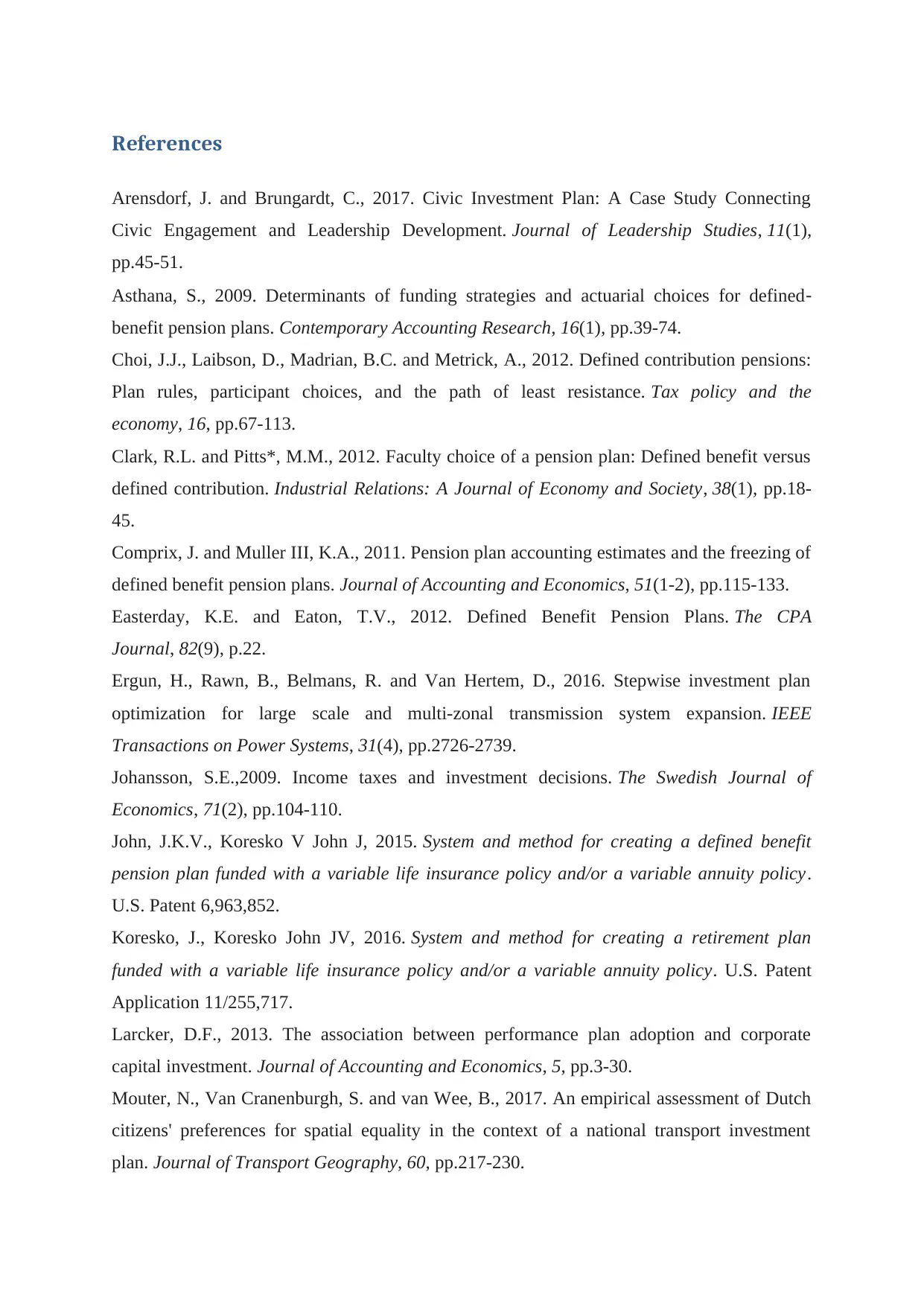
References
Arensdorf, J. and Brungardt, C., 2017. Civic Investment Plan: A Case Study Connecting
Civic Engagement and Leadership Development. Journal of Leadership Studies, 11(1),
pp.45-51.
Asthana, S., 2009. Determinants of funding strategies and actuarial choices for defined‐
benefit pension plans. Contemporary Accounting Research, 16(1), pp.39-74.
Choi, J.J., Laibson, D., Madrian, B.C. and Metrick, A., 2012. Defined contribution pensions:
Plan rules, participant choices, and the path of least resistance. Tax policy and the
economy, 16, pp.67-113.
Clark, R.L. and Pitts*, M.M., 2012. Faculty choice of a pension plan: Defined benefit versus
defined contribution. Industrial Relations: A Journal of Economy and Society, 38(1), pp.18-
45.
Comprix, J. and Muller III, K.A., 2011. Pension plan accounting estimates and the freezing of
defined benefit pension plans. Journal of Accounting and Economics, 51(1-2), pp.115-133.
Easterday, K.E. and Eaton, T.V., 2012. Defined Benefit Pension Plans. The CPA
Journal, 82(9), p.22.
Ergun, H., Rawn, B., Belmans, R. and Van Hertem, D., 2016. Stepwise investment plan
optimization for large scale and multi-zonal transmission system expansion. IEEE
Transactions on Power Systems, 31(4), pp.2726-2739.
Johansson, S.E.,2009. Income taxes and investment decisions. The Swedish Journal of
Economics, 71(2), pp.104-110.
John, J.K.V., Koresko V John J, 2015. System and method for creating a defined benefit
pension plan funded with a variable life insurance policy and/or a variable annuity policy.
U.S. Patent 6,963,852.
Koresko, J., Koresko John JV, 2016. System and method for creating a retirement plan
funded with a variable life insurance policy and/or a variable annuity policy. U.S. Patent
Application 11/255,717.
Larcker, D.F., 2013. The association between performance plan adoption and corporate
capital investment. Journal of Accounting and Economics, 5, pp.3-30.
Mouter, N., Van Cranenburgh, S. and van Wee, B., 2017. An empirical assessment of Dutch
citizens' preferences for spatial equality in the context of a national transport investment
plan. Journal of Transport Geography, 60, pp.217-230.
Arensdorf, J. and Brungardt, C., 2017. Civic Investment Plan: A Case Study Connecting
Civic Engagement and Leadership Development. Journal of Leadership Studies, 11(1),
pp.45-51.
Asthana, S., 2009. Determinants of funding strategies and actuarial choices for defined‐
benefit pension plans. Contemporary Accounting Research, 16(1), pp.39-74.
Choi, J.J., Laibson, D., Madrian, B.C. and Metrick, A., 2012. Defined contribution pensions:
Plan rules, participant choices, and the path of least resistance. Tax policy and the
economy, 16, pp.67-113.
Clark, R.L. and Pitts*, M.M., 2012. Faculty choice of a pension plan: Defined benefit versus
defined contribution. Industrial Relations: A Journal of Economy and Society, 38(1), pp.18-
45.
Comprix, J. and Muller III, K.A., 2011. Pension plan accounting estimates and the freezing of
defined benefit pension plans. Journal of Accounting and Economics, 51(1-2), pp.115-133.
Easterday, K.E. and Eaton, T.V., 2012. Defined Benefit Pension Plans. The CPA
Journal, 82(9), p.22.
Ergun, H., Rawn, B., Belmans, R. and Van Hertem, D., 2016. Stepwise investment plan
optimization for large scale and multi-zonal transmission system expansion. IEEE
Transactions on Power Systems, 31(4), pp.2726-2739.
Johansson, S.E.,2009. Income taxes and investment decisions. The Swedish Journal of
Economics, 71(2), pp.104-110.
John, J.K.V., Koresko V John J, 2015. System and method for creating a defined benefit
pension plan funded with a variable life insurance policy and/or a variable annuity policy.
U.S. Patent 6,963,852.
Koresko, J., Koresko John JV, 2016. System and method for creating a retirement plan
funded with a variable life insurance policy and/or a variable annuity policy. U.S. Patent
Application 11/255,717.
Larcker, D.F., 2013. The association between performance plan adoption and corporate
capital investment. Journal of Accounting and Economics, 5, pp.3-30.
Mouter, N., Van Cranenburgh, S. and van Wee, B., 2017. An empirical assessment of Dutch
citizens' preferences for spatial equality in the context of a national transport investment
plan. Journal of Transport Geography, 60, pp.217-230.
⊘ This is a preview!⊘
Do you want full access?
Subscribe today to unlock all pages.

Trusted by 1+ million students worldwide

Thompson, J.B., Gilbert, J.M. and Hernandez, J.T., BENEFIT RESOURCE Inc,
2012. Benefit management system and method. U.S. Patent 8,234,222.
2012. Benefit management system and method. U.S. Patent 8,234,222.
1 out of 10
Related Documents
Your All-in-One AI-Powered Toolkit for Academic Success.
+13062052269
info@desklib.com
Available 24*7 on WhatsApp / Email
![[object Object]](/_next/static/media/star-bottom.7253800d.svg)
Unlock your academic potential
Copyright © 2020–2025 A2Z Services. All Rights Reserved. Developed and managed by ZUCOL.





